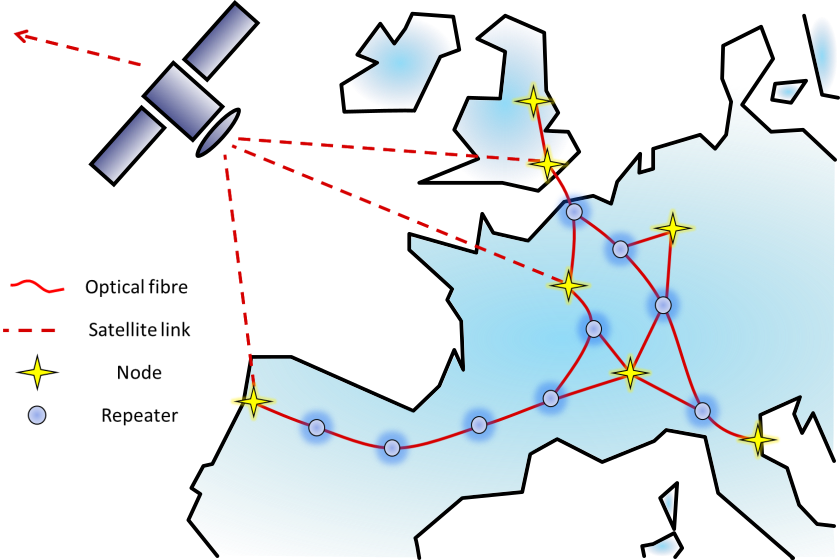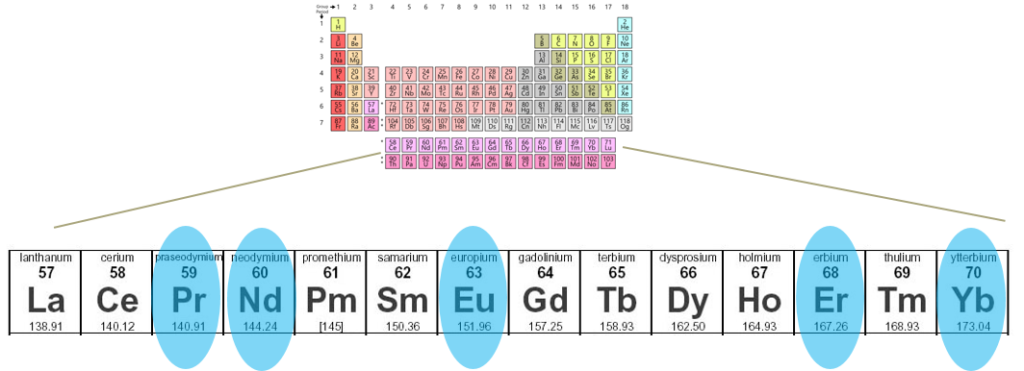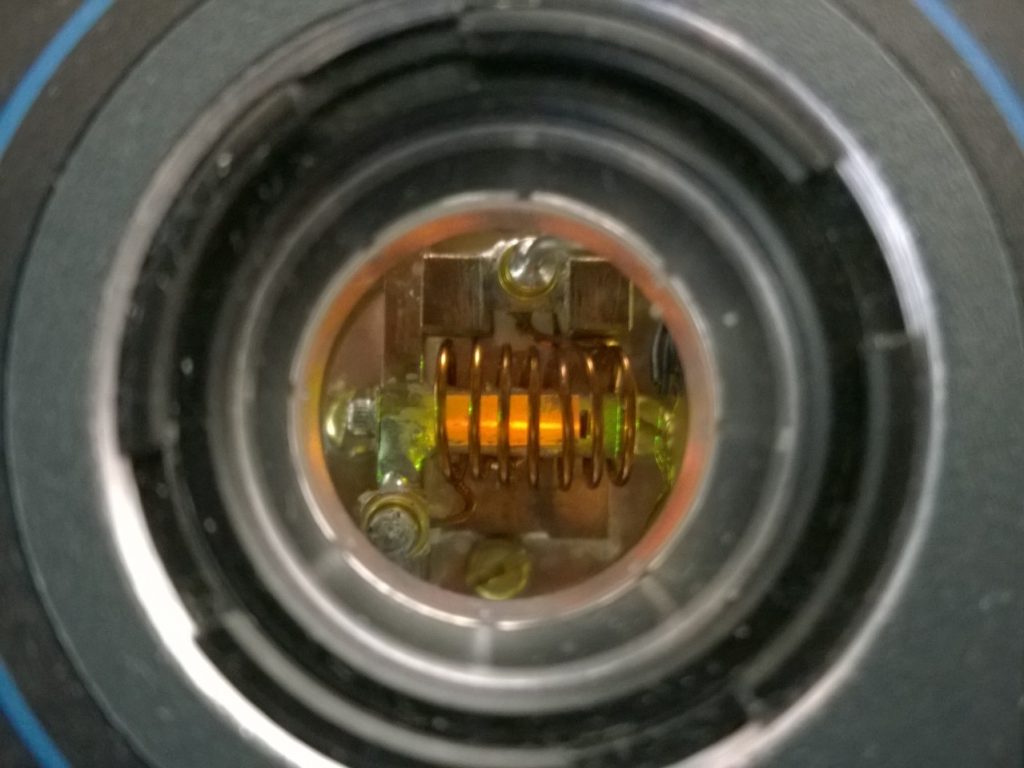Antonio works on Solid state crystals for quantum repeaters, do you like to know more? Please continue to read!
Quantum physics has some peculiar properties which can enhance the security and privacy of long-distance communication, a topic very relevant today and likely to become even more so in the near future. Moreover, quantum computers will need to be connected in a way compatible with their quantum nature. This is why preparing the ground for an implementation of quantum communication over future quantum networks is among the goals of the QCALL project. This task includes working on the physical devices that one day will make a quantum network functional.
Actually, the backbone of a quantum network already exists. Optical fibres are extensively used for high speed internet connection, and this is no coincidence. Light is an excellent carrier of information, given its speed that no other particle can reach, and it can be easily manipulated with modern technology, especially thanks to the laser. In addition, photons are among the most versatile physical systems in which a quantum state can be created, controlled and transferred. It seems only logical to exploit the existing fibre network to transmit also quantum states.
Quantum memories and repeaters
However, the present network is not ready yet for quantum communication. One of the reasons is that the quantum state of a photon is more fragile than the classical analogue of a simple pulse of light. Optical fibres are not perfect, and loss of information becomes a serious problem when speaking of long distances. In a state-of-the-art optical fiber, half of the photons in a laser pulse are lost every 17 km. While for classical information this can be compensated by repeater stations, where light pulses are amplified, this is not possible with quantum states as a consequence of the more fundamental no-cloning theorem.
We therefore need to rethink the concept of quantum repeater and adapt it to the rules of quantum physics. So far, several protocols have been proposed which exploit another feature typical of the quantum world: entanglement. In simple words, two or more particles are said to be entangled when they exist in a global state that cannot be simply described as a product of the states of the individual particles. A consequence of the entanglement is that interacting with one of these particles will also affect the result of any measurement of the properties of the others, which can be used for instance to prove the security of a communication channel. A quantum repeater then needs to be able to distribute entangled states between the network nodes, but also store these states in order to maintain a link with a node active for some time and allow the synchronization of multiple direct links that will finally connect the nodes at the extreme ends of the channel.
This is where quantum memories enter the game. At the core of a quantum repeater, these devices interact with incoming photons, store their state in some internal degrees of freedom, and release it after some time that can be chosen on-demand. All this while preserving the quantum properties of the stored state, including the entanglement with other photons and nodes of the network.

The quest for better memories
My task in the QCALL project, and as a PhD student in the group supervised by Mikael Afzelius at the University of Geneva in Switzerland, is to work on the practical side of the implementation of a quantum repeater, in particular by studying some novel candidate materials for quantum memories and to demonstrate storage of entanglement in such memories. Several physical systems have been proposed already for the purpose, most of them relying on groups (or more properly, ensembles) of atoms that can collectively interact with photons and potentially store the information they carry in their internal degrees of freedom. The strength of using a collection of many atoms is that, like a team, they can work together to enhance the probability that incoming photons will interact with any of them, and together keep trace of the information stored until the moment is chosen for it to be released as another photon. Another great advantage of ensemble-based memories is that an ensemble of atoms can store many photons at a time, and this multiplexing ability is key in order to reach reasonable communication rates. Here in Geneva we decided to work with a specific family of atoms, called rare earth elements, embedded in solid state crystals.
Rare earth elements are, despite the name, relatively common in the Earths’ crust and used widely in modern technology. For instance, one can find them in tv screens, smartphones and computer components. But how can they be useful in our quest for a quantum memory?

Advantages and challenges
As mentioned before, a quantum state is a delicate thing, be it a photon or an ensemble of rare earth ions in a crystal. Even if one manages to prepare a quantum state in a particle, in normal conditions it won’t last long. Most probably, our particle will interact with its environment very quickly, modifying the state in unpredictable ways. This is why, in our system, rare earth ions are embedded in specific types of crystals, which contain mostly elements that interact only weakly with the ions themselves or with the environment, on the condition that their temperature is of just few Kelvin above absolute zero, which is easily obtained with commercially available cryostats.
But how can we make sure our system is resilient to perturbations? A way of quantifying this is to measure the coherence lifetime: in other words, for how long our group of ions can keep working as a team in preserving the stored information without them “losing coherence” between themselves and with respect to the intial state of the photon absorbed. This is the crucial metric for a system to be able to preserve a quantum state.
When cooled, rare earth ions can easily record coherence lifetimes ranging from hundreds of microseconds to even a few seconds, depending on the specific element. This numbers might sound small, but from the point of view of a photon it’s actually a lot: to give an idea, in 100 microseconds a photon covers about 20 km in an optical fibre! However, a long coherence lifetime is not the only property we need. Other questions we have to answer are: is the colour (or frequency) of the light we want to use for communication compatible with our ions? How much information can we store in a given timeframe (multiplexing and bandwidth)? Can a state of light be efficiently absorbed and re-emitted without being distorted?
Unfortunately, so fare none of the physical systems proposed as a quantum memory can answer affirmatively to all these questions at the same time. In the specific case of rare earths, for instance, erbium is the most compatible with the infrared photons that are currently used in telecommunications (1500 nm of wavelength), but it suffers from high sensitivity to external perturbations. Praseodymium is very efficient in absorbing photons, but mainly for red light (600 nm), and its coherence lifetime is good but far from the best. Europium is very resistant to perturbations, but it is also much less efficient than praseodymium, and again at the wrong colour (yellow, 580 nm).
All these issues are being tackled with constant progress by various groups of researchers around the globe. For example, frequency conversion can solve the “wrong colour” problem at a price in efficiency; optical cavities can help the efficiency, but also reduce the bandwidth; and other techniques involving active control of the ions’ environment can reduce their sensitivity to perturbations and increase the effective coherence time, while adding more complexity to the storage protocol and demanding more resources. In any case, the exploration of new materials that can help improve all these aspects is still ongoing.
Our new entry: ytterbium
This is what the first part of my PhD was about. We studied a relatively unexplored rare earth element, ytterbium, in a host crystal called yttrium orthosilicate (YSO in short). It absorbs in the near infrared (980 nm), but its main strength, to begin with, is the bandwidth. Its electrons and nucleus can be addressed with photons at several frequencies, a bit like a cabinet with multiple shelves, which are well separated by at least half a GHz. This ultimately sets the bandwidth limitation of the memory! This is an advantage with respect to many of the most successful rare earths so far, for which this range is limited to tens of MHz of bandwidth only! (as in europium and praseodymium). In principle, increasing the bandwidth of the memory will lead to a larger operating speed of the repeater, and thus a faster connection rate in a quantum network.
The big unknown was the coherence lifetime. But we unexpectedly discovered that ytterbium can reach more than 1 ms if we choose to store a light pulse in specific internal states, created by an interplay of the intrinsic property of electrons and nuclei, called spin. At first this was very surprising, since usually materials with a non-zero electronic spin are extremely sensitive to perturbations due to magnetic field fluctuations, normally present in the environment and in the host crystal. In other materials with similar sensitivity to magnetic fields, this problem is typically suppressed by techniques involving huge external magnetic fields (around some Teslas), which are impossible to achieve without additional expensive equipment such as superconducting magnets. However, the internal states of ytterbium in our crystal were found to have a nice “stability valley” for magnetic field values close to zero. Its sensitivity to fluctuations is dependent on the value of the magnetic fields, and it happens to be null when no field is present at all!
The spin property of ytterbium’s electrons offers another useful feature. Despite the insensitivity to the slow field fluctuations due to the environment, the quantum information stored within the electrons can efficiently be manipulated using microwave pulses. This opens the possibility that a future quantum memory based on ytterbium could interact directly with superconducting qubits, which are at the core of the most commercially exploited quantum computing platforms. These qubits are typically controlled with signals in a similar range of frequencies and cannot be exposed to the high magnetic fields required by other rare earths.
Our results were published in two papers, one highlighting the applicative potential of ytterbium in Nature Materials and one reporting the underlying spectroscopic properties of the material in Physical Review. We also had the chance to present the work at several conferences, and to a broader public thanks to scientific news outlets around the web (for instance, see Science Daily).
Our workhorse: europium
While the ytterbium project progressed towards the implementation of the first storage experiments, I switched to another rare earth element being studied for a longer time in our labs: europium. Its main strength is the long coherence lifetime, which made it one of the main contenders for implementing a quantum repeater, together with praseodymium. In europium, a group in Australia obtained the record coherence time (original paper here) extrapolated from measured data: 6 hours, achieved with a sophisticated method of suppression of magnetic noise at an applied 7 Teslas of magnetic field. We do not need to reach those values for practical repeaters, but it shows the potential of europium.

In our group, europium in a YSO host was shown (original paper here) to be able to create pairs of single photons correlated in time, with a time delay between them. More precisely, after being excited by a weak laser pulse, an ion of europium can change its spin state by emitting a single photon. This photon heralds a successful excitation of a single spin of the ensemble. After some time, which amounted to 1 ms in our last implementation, this excitation is released as a second photon. Using certain test, one can prove that the second photon really originated from the same excitation that produced the first one. The experiment outlined forms the basis of the DLCZ quantum repater (named after its inventors, Duan, Lukin, Cirac and Zoller), which we adapted to our crystals, and that can be used to entangle two distant nodes in a quantum network. Based on these results, we have implemented several improvements of the setup used to control our quantum memory, focused on the reduction of the noise that limited the previous experiment.
Right now, we find ourselves at the point where all these improvements are being combined and tested, in order to show that pairs of entangled photons can be produced in europium, and afterwards converted into telecom frequencies. In the meantime, ytterbium is still progressing and being used in our first storage protocols. As mentioned before, all materials have their own strengths and weaknesses, making them suitable for different applications depending on which features we want our repeater to have. In any case, we will continue working towards the goal of preparing a functional quantum repeater unit and implementing it in a fibre network.









